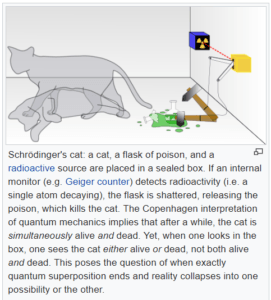[This article is under construction.]

In fact, the mathematics was saying even more. The wave function has a mathematical property called “linearity.” This property means that when the photon superposition interacts with the photographic plate, the superposition should “infect” the photographic plate. The photographic plate becomes correlated with the photon. It should, itself, go into a superposition like the photon.
Instead the wave function collapses down to a particle. Rather than going into a superposition, the photographic plate stays solidly there.
The Schrodinger Cat thought experiment highlights the problem of the cause of the collapse of the wave function. Here’s the experiment: A radioactive atom is in a superposition of two states: 1) decay in which it emits an electron and 2) stability in which it doesn’t. The atom is in a box with a hapless cat and a Geiger counter. If the atom decays and emits the electron, it triggers the Geiger counter, which releases a hammer, which breaks a vial, which releases a poison gas, which kills the cat.
The property of linearity of the wave function tells physicists that the superposition of the atom, both decayed and undecayed, would put the Geiger counter into a superposition. The superposition of the Geiger counter would, in turn, infect the hammer, which would go into a superposition. And so on, until the cat, itself, is in a superposition of being both dead and alive. But this does not describe the reality that we experience. Who has seen a cat that is both dead and alive? What actually happens in the physical universe that saves us from zombie cats?
Some interpretations of quantum mechanics do not hold that the wave function actually collapses. The Many Worlds Interpretation is the most well-known of these. In the heyday of the Copenhagen Interpretation, some physicists proposed that consciousness collapses the wave function and prevents the atom’s superposition from infecting the entire Rube Goldberg cat-killing machine. In later decades, the theory of decoherence was developed to explain wave function collapse.
